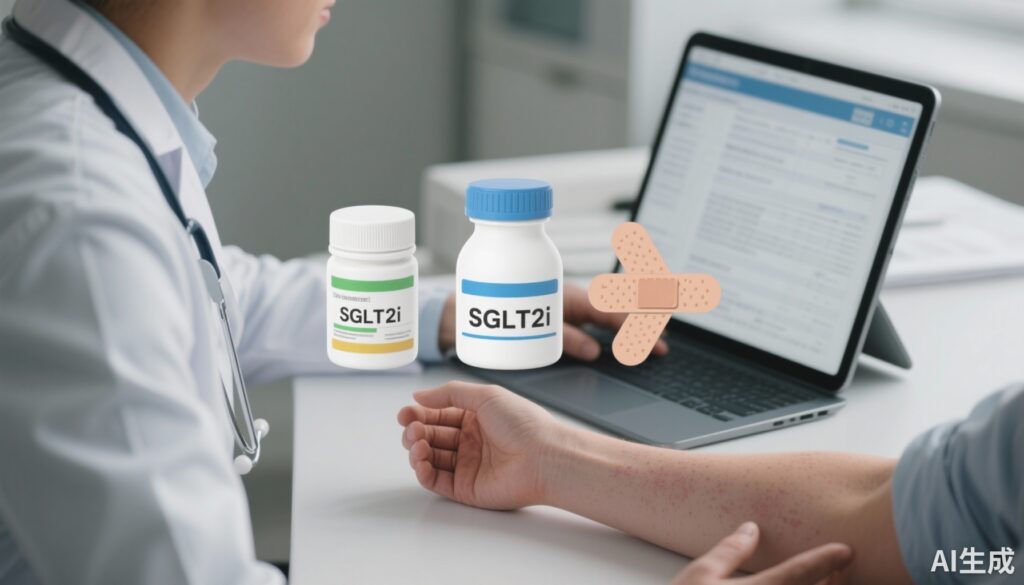Highlights
– Nationwide active-comparator cohort (Taiwan NHID) compared SGLT2 inhibitors (n=148,354) with DPP‑4 inhibitors (n=322,703) for risk of new-onset atopic dermatitis (AD).
– SGLT2i use associated with lower AD incidence (9.742 vs 12.070 per 1,000 person‑years) and reduced risk (IPTW-adjusted HR 0.847) versus DPP‑4i.
– Dose-response signal: highest SGLT2i dose linked to greatest reduction in AD risk (IPTW-adjusted HR 0.647); effect seen across drug types and sensitivity analyses and stronger in men (IPTW-adjusted HR 0.750).
Background and clinical context
Atopic dermatitis (AD) is a common inflammatory skin disease characterized by eczematous lesions, pruritus and barrier dysfunction. While frequently studied in pediatric populations, adult-onset AD is increasingly recognized and can contribute substantially to morbidity and healthcare use. Patients with type 2 diabetes mellitus (T2DM) may have altered skin barrier function, altered immune responses and greater risk of diverse dermatologic conditions, making study of medication-related dermatologic outcomes clinically relevant.
Sodium‑glucose cotransporter‑2 inhibitors (SGLT2i) are an established class of glucose-lowering agents that reduce renal glucose reabsorption and promote glucosuria and natriuresis. Beyond glycemic control, large outcome trials have demonstrated consistent cardiovascular and renal protection for several SGLT2i. Less is known, however, about the influence of SGLT2i on immune-mediated or inflammatory skin diseases such as AD. Comparators such as dipeptidyl peptidase‑4 inhibitors (DPP‑4i) are widely used in the same therapeutic context and have previously been associated with certain cutaneous adverse events (for example, bullous pemphigoid in pharmacovigilance and observational studies), making them a reasonable active-comparator class for pharmacoepidemiologic evaluation.
Study design and methods
The referenced study by Wen et al. (Br J Dermatol. 2025) used Taiwan’s National Health Insurance Database to perform a nationwide, active‑comparator cohort analysis. Adults with T2DM who initiated either an SGLT2i (study group, n=148,354) or a DPP‑4i (active comparator, n=322,703) between May 2016 and December 2018 were included, with a 12‑month washout for prior SGLT2i or DPP‑4i exposure. The primary outcome was incident AD identified using diagnostic codes recorded after cohort entry.
To address confounding by indication and covariate imbalance, inverse probability of treatment weighting (IPTW) was applied to balance baseline demographics, comorbidities and prior medication use across groups. The authors used Cox proportional hazards models to estimate hazard ratios (HRs) for AD. Multiple sensitivity analyses, subgroup analyses (including sex-specific assessment) and dose-response evaluation were performed to test robustness.
Key findings
Incidence: During follow-up, SGLT2i users had a lower crude incidence of new-onset AD than DPP‑4i users (9.742 vs 12.070 cases per 1,000 person‑years).
Primary adjusted analysis: After IPTW adjustment, SGLT2i use was associated with a significantly lower hazard of developing AD compared with DPP‑4i use (IPTW-adjusted HR 0.847).
Consistency across agents: The protective association was observed across different individual SGLT2 inhibitors included in the cohort, suggesting a class effect rather than a single‑agent phenomenon.
Dose-response: A graded relationship was reported — the highest cumulative or prescribed SGLT2i dose correlated with the greatest reduction in AD risk (IPTW-adjusted HR 0.647), supporting plausibility and internal consistency.
Sex differences: The association appeared stronger in men (IPTW-adjusted HR 0.750) than in women, indicating potential effect modification by sex.
Sensitivity and robustness: The finding remained stable across multiple sensitivity analyses designed to alter outcome definition, lagging exposure, and censoring rules, strengthening confidence in the primary observation.
Interpretation and biological plausibility
The observed inverse association between SGLT2i use and incident AD raises several possible mechanistic explanations, though causal inference cannot be confirmed from an observational design.
Potential mechanisms:
- Metabolic and immunologic modulation: SGLT2i produce systemic metabolic shifts (improved glycemic variability, weight loss, natriuresis) that may indirectly attenuate low-grade systemic inflammation. Metabolic improvement can influence immune cell activation and cytokine milieus implicated in AD pathogenesis (for example, Th2 and barrier-related pathways).
- Direct anti-inflammatory effects: Preclinical and translational work has suggested SGLT2 inhibition may reduce oxidative stress and downregulate inflammatory signaling in tissues. Whether similar modulation occurs in skin or skin‑resident immune cells in humans remains to be demonstrated.
- Altered skin microenvironment: Changes in fluid, electrolyte balance or local glucose concentrations could conceivably influence skin barrier function or the cutaneous microbiome, with downstream effects on AD susceptibility.
- Comparator class effects: DPP‑4 inhibitors have been associated in some reports with immune‑mediated cutaneous events (notably bullous pemphigoid). If DPP‑4i exposure increases risk of certain dermatologic conditions relative to neutral agents, then an active-comparator analysis would show a relative protective association for the other agent. The study attempt to minimize this bias by choosing DPP‑4i, but residual class-specific effects cannot be excluded.
Overall, while the findings are biologically plausible, they are hypothesis-generating and require mechanistic confirmation.
Strengths and limitations
Strengths
- Large, nationwide sample with comprehensive prescription and diagnostic capture, improving statistical power to detect uncommon outcomes and enhancing external validity within the Taiwanese population.
- Active‑comparator design reduces confounding by indication compared with non‑user comparators.
- Use of IPTW and multiple sensitivity analyses to address measured confounding and test robustness of findings.
Limitations
- Observational design — residual confounding from unmeasured variables (e.g., smoking, atopic history in childhood, family history, body mass index if not fully captured, environmental exposures, over‑the‑counter topical treatments) may persist.
- Outcome ascertainment relied on administrative diagnostic codes, which can misclassify dermatologic diagnoses; data on clinical severity, lesion distribution, biopsy confirmation or investigator adjudication were not available.
- Generalizability outside Taiwan and to populations with different ethnicities, healthcare practices or baseline AD risk requires caution.
- Potential comparator bias: DPP‑4i may carry its own dermatologic risk profile; a neutral comparator or active comparators from more than one class could complement these findings.
- No mechanistic biomarkers or skin‑specific evaluations were included, limiting biological inference.
Clinical implications and research priorities
For clinicians managing adults with T2DM, these data add an intriguing potential dermatologic benefit to the growing list of SGLT2i effects. However, treatment selection should remain grounded in established indications (cardiorenal protection, glycemic control, patient comorbidities and preferences) and safety considerations (e.g., risk of genital mycotic infections, volume depletion, lower‑extremity amputations with some agents historically). The magnitude of absolute risk reduction for AD is modest, and the decision to use SGLT2i should not be driven solely by potential reduction in AD risk at this time.
Key research needed:
- Replication in other national cohorts and different ethnic groups, including comparison with additional active comparators and new-user designs with extended covariate capture.
- Prospective studies incorporating clinical dermatologic assessment, severity scoring, skin biopsy and biomarkers to establish temporality and mechanisms.
- Basic and translational research to probe how SGLT2 inhibition might modulate skin immunity, barrier function and the microbiome.
- Analyses of patient‑level absolute risk differences and number needed to treat to prevent one case of AD, to place the finding in clinical perspective.
Conclusion
The nationwide active‑comparator study by Wen et al. reports an association between SGLT2 inhibitor use and lower risk of new‑onset atopic dermatitis compared with DPP‑4 inhibitor use in adults with T2DM. The association was consistent across drug types, robust to sensitivity analyses, exhibited a dose‑response pattern and appeared stronger in men. While mechanistically plausible, these observational findings are hypothesis‑generating and should not yet change prescribing solely for dermatologic prevention. They do, however, prompt further mechanistic and confirmatory epidemiologic work to determine whether SGLT2 inhibition exerts a true protective effect against AD and, if so, through what pathways.
Funding and clinicaltrials.gov
Funding: See original publication for details of funding sources and disclosures (Wen YL et al., Br J Dermatol. 2025).
ClinicalTrials.gov: Not applicable (observational database study).
References
1. Wen YL, Hsu WT, Chen YH, Kao HH, Liao CC, To SY, Yang HW, Kao LT. Sodium‑glucose cotransporter 2 inhibitors and inverse risk of new‑onset atopic dermatitis in a cohort with diabetes: a nationwide active‑comparator study. Br J Dermatol. 2025 Jun 20;193(1):74‑84. doi:10.1093/bjd/ljaf086. PMID: 40037684.
2. American Diabetes Association. Standards of Medical Care in Diabetes—2024. Diabetes Care. 2024;47(Suppl 1):S1‑S278.
3. Zinman B, Wanner C, Lachin JM, et al.; EMPA‑REG OUTCOME Investigators. Empagliflozin, cardiovascular outcomes, and mortality in type 2 diabetes. N Engl J Med. 2015;373:2117‑2128.
4. Perkovic V, Jardine MJ, Neal B, et al.; CREDENCE Trial Investigators. Canagliflozin and renal outcomes in type 2 diabetes and nephropathy. N Engl J Med. 2019;380:2295‑2306.
AI thumbnail prompt
A clinically dressed physician and a middle‑aged patient reviewing an electronic chart on a tablet; foreground shows a transparent overlay of a pill bottle labeled ‘SGLT2i’ and a stylized forearm with mild eczematous rash; clean clinic environment, warm neutral tones, photorealistic, 3:2 aspect ratio.






